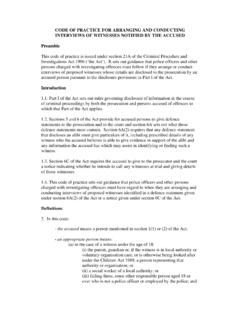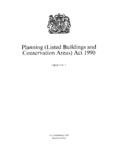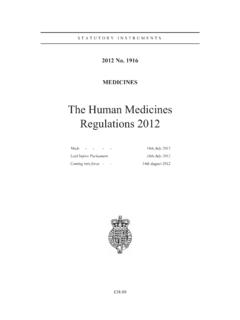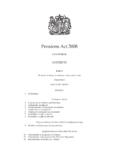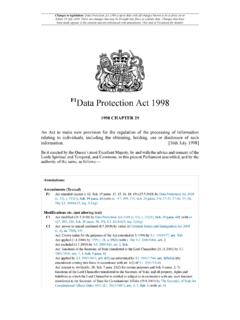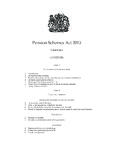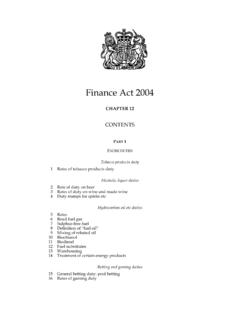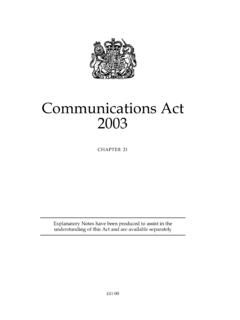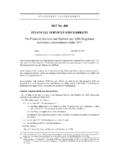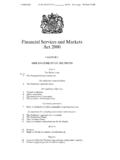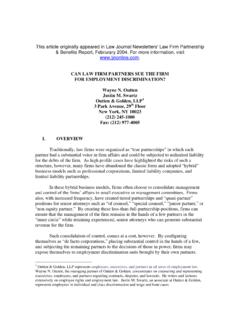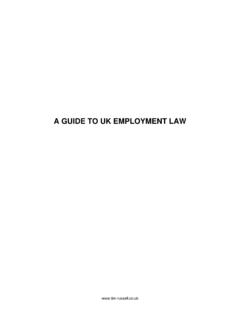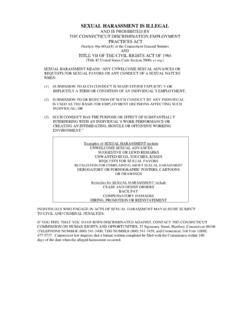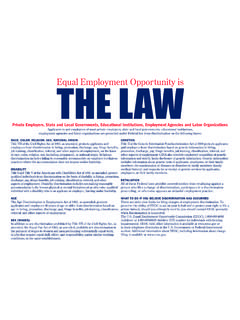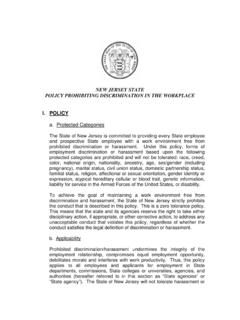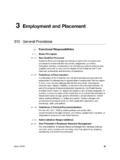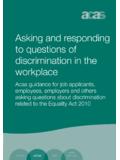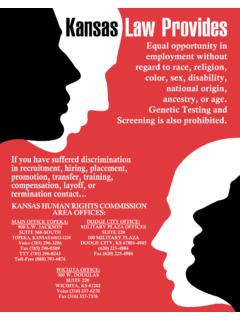Transcription of The Employment Tribunals (Constitution and Rules of ...
1 STATUTORY INSTRUMENTS. 2013 No. 1237. Employment Tribunals . The Employment Tribunals (Constitution and Rules of Procedure) Regulations 2013. Made - - - - 28th May 2013. Laid before Parliament 31st May 2013. Coming into force for the purpose of regulations 1, 3. and 11 1st July 2013. for all other purposes 29th July 2013. STATUTORY INSTRUMENTS. 2013 No. 1237. Employment Tribunals . The Employment Tribunals (Constitution and Rules of Procedure) Regulations 2013. Made - - - - 28th May 2013. Laid before Parliament 31st May 2013. Coming into force for the purpose of regulations 1, 3. and 11 1st July 2013. for all other purposes 29th July 2013. The Secretary of State, in exercise of the powers conferred by section 24(2) of the Health and Safety at Work etc. Act 1974(a), sections 1(1), 4(6) and (6A), 7(1), (3), (3ZA), (3A), (3AA), (3AB), (3B), (3C) and (5), 7A(1) and (2), 7B(1) and (2), 9(1) and (2), 10(2), (5), (6) and (7), 10A(1), 11(1), 12(2), 13, 13A, 19, and 41(4) of the Employment Tribunals Act 1996(b), paragraph 37 of Schedule 6 to the Scotland Act 1998(c), and paragraph 32 of Schedule 9 to the Government of Wales Act 2006(d), makes the following Regulations.
2 The Secretary of State has consulted with the Administrative Justice and Tribunals Council, and that Council has consulted with the Scottish Committee and the Welsh Committee, in accordance with paragraph 24 of Schedule 7 to the Tribunals , Courts and Enforcement Act 2007(e). (a) 1974 c. 37. (b) 1996 c. 17; by virtue of section 1 of the Employment Rights (Dispute Resolution) Act 1998 (c. 8) industrial Tribunals were renamed Employment Tribunals and references to industrial tribunal and industrial Tribunals in any enactment were substituted with Employment tribunal and Employment Tribunals . Section 4(6) was amended by the Employment Rights (Dispute Resolution) Act 1998, Schedule 1, paragraph 12(4), and by the Tribunals , Courts and Enforcement Act 2007 (c. 15), Schedule 8, paragraphs 35 and 37.
3 Section 4(6A) was inserted by the Employment Rights (Dispute Resolution) Act 1998, section 3(6), and amended by the Tribunals , Courts and Enforcement Act 2007, Schedule 8, paragraphs 35 and 37. Section 7(3)(f)(i) was repealed by the Employment Rights (Dispute Resolution) Act 1998, Schedule 1, paragraph 14(2);. section 7(3)(ia) was inserted by the Employment Act 2002 (c. 22), section 24(1); and section 7(3)(h) was amended by the Equality Act 2010 (c. 15), Schedule 26, paragraphs 27 and 29. Section 7(3ZA) was inserted by the Employment Act 2002, section 25. Section 7(3A) to (3C) was inserted by the Employment Rights (Dispute Resolution) Act 1999, section 2, and section 7(3A) was then substituted by the Employment Act 2002, section 26. Section 7(3AA) and (3AB) was inserted by the Employment Act 2008 (c.)
4 24), section 4. Section 7A was inserted by the Employment Act 2002, section 27, and section 7A(1) was amended by the Tribunals Courts and Enforcement Act 2007, Schedule 8, paragraphs 35 and 41. Section 7B was inserted by the Tribunals , Courts and Enforcement Act 2007, Schedule 8, paragraphs 35 and 42. Sections 10 and 10A were substituted by the Employment Relations Act 1999 (c. 26), Schedule 8, paragraph 3, and section 10(6) was then substituted by the Employment Relations Act 2004 (c. 24), section 36. Section 12 was amended by the Equality Act 2010, Schedule 26, paragraphs 27 and 30. Section 13 was amended by the Employment Act 2002, section 22(1). Section 13(2) was amended by the Employment Relations Act 1999, section 44, Schedule 4, paragraph 4 of Part III, and Schedule 9.
5 Section 13A was inserted by the Employment Act 2002, section 22(2). Section 19(1) was renumbered as such by the Employment Act 2002, section 24(4), and was amended by sections 24(3), 53 and 54 of, and Schedule 7, paragraph 23(1) and (3), and Schedule 8. to, that Act. (c) 1998 c. 46. (d) 2006 c. 32. (e) 2007 c. 15. Citation and commencement 1. (1) These Regulations may be cited as the Employment Tribunals (Constitution and Rules of Procedure) Regulations 2013 and the Rules of Procedure contained in Schedules 1, 2 and 3 may be referred to, respectively, as . (a) the Employment Tribunals Rules of Procedure 2013;. (b) the Employment Tribunals (National Security) Rules of Procedure 2013; and (c) the Employment Tribunals (Equal Value) Rules of Procedure 2013. (2) This regulation and regulations 3 and 11 come into force on 1st July 2013 and the remainder of these Regulations (including the Schedules) come into force on 29th July 2013.
6 Revocation 2. Subject to the savings in regulation 15 the Employment Tribunals (Constitution and Rules of Procedure) Regulations 2004(a) are revoked. Interpretation 3. Except in the Schedules which are subject to the definitions contained in the Schedules, in these Regulations . 2004 Regulations means the Employment Tribunals (Constitution and Rules of Procedure). Regulations 2004;. appointing office holder means, in England and Wales, the Lord Chancellor, and in Scotland, the Lord President;. Employment Tribunals Act means the Employment Tribunals Act 1996;. Lord President means the Lord President of the Court of Session;. national security proceedings means proceedings in relation to which a direction is given, or an order is made, under rule 94 of Schedule 1.
7 President means either of the two presidents appointed from time to time in accordance with regulation 5(1);. Regional Employment Judge means a person appointed or nominated in accordance with regulation 6(1) or (2);. Senior President of Tribunals means the person appointed in accordance with section 2 of the Tribunals , Courts and Enforcement Act 2007;. Tribunal means an Employment tribunal established in accordance with regulation 4 and, in relation to any proceedings, means the Tribunal responsible for the proceedings in question, whether performing administrative or judicial functions;. Vice President means a person appointed or nominated in accordance with regulation 6(3). or (4). Establishment of Employment Tribunals 4. There are to be Tribunals known as Employment Tribunals .
8 President of Employment Tribunals 5. (1) There shall be a President of Employment Tribunals , responsible for Tribunals in England and Wales, and a President of Employment Tribunals , responsible for Tribunals in Scotland, appointed by the appointing office holder. (2) A President shall be . (a) 2004/1861. 2. (a) a person who satisfies the judicial-appointment eligibility condition within the meaning of section 50 of the Tribunals , Courts and Enforcement Act 2007 on a 5-year basis;. (b) an advocate or solicitor admitted in Scotland of at least five years standing; or (c) a member of the Bar of Northern Ireland or solicitor of the Supreme Court of Northern Ireland of at least five years standing. (3) A President may at any time resign from office by giving the appointing officer holder notice in writing to that effect.
9 (4) The appointing officer holder may remove a President from office on the ground of inability or misbehaviour, or if the President is adjudged to be bankrupt or makes a composition or arrangement with his creditors. (5) Where a President is unable to carry out the functions set out in these Regulations, those functions may be discharged by a person nominated by the appointing office holder (save that any nomination in relation to England and Wales shall be made by the Lord Chief Justice following consultation with the Senior President of Tribunals , rather than by the Lord Chancellor). (6) The Lord Chief Justice may nominate a judicial office holder (as defined in section 109(4) of the Constitutional Reform Act 2005(a)) to exercise his functions under this regulation.
10 Regional Employment Judges and the Vice President 6. (1) The Lord Chancellor may appoint Regional Employment Judges. (2) The President (England and Wales) or the Regional Employment Judge for an area may nominate an Employment Judge to discharge the functions of the Regional Employment Judge for that area. (3) The Lord President may appoint a Vice President. (4) The President (Scotland) or the Vice President may nominate an Employment Judge to discharge the functions of the Vice President. (5) Appointments and nominations under this regulation shall be from the full-time Employment Judges on the panel referred to in regulation 8(2)(a). Responsibilities of the Presidents, Regional Employment Judges and Vice President 7. (1) The President shall, in relation to the area for which the President is responsible, use the resources available to.
